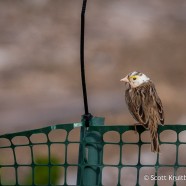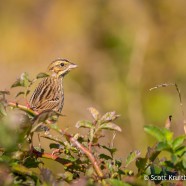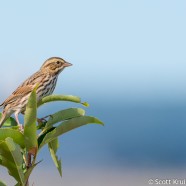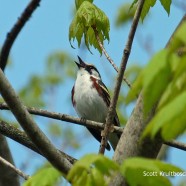Leucistic Savannah Sparrow
This appears to be a partially leucistic Savannah Sparrow, a migrant individual that I was surprised by yesterday morning. Leucism is when pigments are produced at less than normal levels or in an unexpected pattern. In this case many of the feathers on the head and throat do not have typical pigmentation. Interestingly the yellow patch on the face can still be seen, giving this unique bird an all the more fascinating look. Scott Kruitbosch Conservation & Outreach Coordinator
Read MoreSavannah Sparrow
Masses of Savannah Sparrows are still on the move right now, pushing through our fields, grasslands, shrublands, farmlands and other open areas with significant food supplies and enough room to hide. Autumn allows you to study so many individual birds that show us how much variance there can be within what we call a species.
Read MoreSavannah Sparrow
This Savannah Sparrow (Passerculus sandwichensis) was one of dozens of migrants of the species that I spotted this past weekend. Their numbers are increasing as they head south for the winter. As we go deeper into autumn we will see hundreds of them in fields, grasslands and farms across large open spaces in areas like Chautauqua County or coastal scrub and shrub habitat in locations such as Stratford Point. Get those Peterson Field Guides ready! They will not all be this easy to identify…
Read MoreChestnut-sided Warbler close-ups
Today while conducting field work for several hours at a few sites in Pennsylvania I enjoyed numerous great looks at Chestnut-sided Warblers. These birds of shrub/scrub habitat and secondary growth are distinctive and beautiful in appearance and song. Whenever I see them now I am reminded of Twan and Sean and RTPI’s work in the tropics. In Costa Rica in the Chestnut-sided wintering range they enjoy watching the birds turn into little “meatballs” as they fatten up for the flight north. In fact a Chestnut-sided Warbler banded in Rara Avis was recaptured twice over a four year...
Read More







